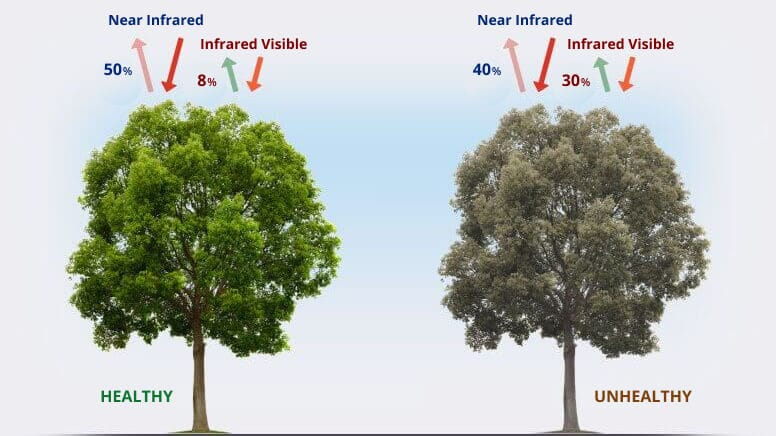Contact: +91 99725 24322 |
Menu
Menu
Quick summary: Unlocking the potential of NDVI for sustainable agriculture: Learn how Tracex solutions harness NDVI technology to optimize crop management, enhance resource utilization, and drive eco-friendly practices for a greener future.

The Normalized Difference Vegetation Index (NDVI) is a remote sensing index that is used to measure the amount of vegetation in an area. With the growing interventions of technology, NDVI is finding its fortune in sustainable agriculture too.
NDVI is a valuable tool for monitoring vegetation health and productivity. It can be used to identify areas of stress or damage, track changes in vegetation cover over time, and assess the impact of climate change on vegetation. NDVI is also used to map and classify vegetation types, and to estimate crop yields.
NDVI calculated by taking the difference between the reflectance of near-infrared (NIR) and red light from a plant and then dividing by the sum of the reflectance. NDVI values range from -1 to 1, with negative values indicating water or bare soil, and positive values indicating vegetation. Higher NDVI values indicate more vegetation.
The principle behind NDVI is that healthy vegetation strongly absorbs visible red light for photosynthesis and reflects a significant amount of near-infrared light. Unhealthy or sparse vegetation, on the other hand, reflects more red light and absorbs less near-infrared light. By quantifying the ratio between these two spectral bands, NDVI provides a reliable indicator of vegetation density, greenness, and overall health.

The formula for calculating NDVI is:
In this formula, NIR represents the reflectance value in the near-infrared spectrum, and Red represents the reflectance value in the red spectrum.
NDVI values range from -1 to +1. A value close to -1 indicates little to no vegetation cover, such as bare soil or water bodies. A value close to +1 indicates dense and healthy vegetation cover. Values around zero suggest non-vegetated or sparse vegetation areas.
NDVI represents the density and vigor of vegetation. It quantifies the difference between the amount of near-infrared light reflected by chlorophyll-rich vegetation and the amount of red light absorbed by chlorophyll. Higher NDVI values indicate healthier and more abundant vegetation, while lower values indicate stressed or sparse vegetation.
By analyzing NDVI images and comparing NDVI values across different areas, farmers and agronomists can identify regions with stressed vegetation and implement appropriate interventions to address the underlying causes of stress. This targeted approach helps optimize resource use, improve crop health, and promote sustainable agriculture practices.
Overall, NDVI analysis provides valuable insights into the health and condition of vegetation, enabling farmers to make informed decisions and implement sustainable practices that enhance agricultural productivity, resource efficiency, and environmental sustainability.
NDVI serves as a powerful tool for assessing crop health and identifying nutrient deficiencies. By analyzing NDVI values across agricultural fields, farmers can discern areas with low NDVI readings, indicating potential nutrient deficiencies. Certain nutrients, such as nitrogen, directly influence chlorophyll production and photosynthetic activity, impacting NDVI values. This information allows for targeted nutrient management strategies, including precise fertilizer application and the implementation of precision agriculture techniques. By addressing specific nutrient needs within different areas of the field, farmers can enhance crop health, optimize resource use, and reduce the environmental impact of excessive fertilizer application.
Timely detection of pest or disease outbreaks is crucial for minimizing crop losses and reducing the need for widespread pesticide use. NDVI analysis provides a means to identify regions with declining NDVI values, indicating potential pest or disease hotspots. As infested or infected crops exhibit diminished health, their NDVI values decrease in comparison to healthy vegetation. By monitoring NDVI over time, farmers can promptly detect areas with declining NDVI readings, enabling targeted interventions such as implementing pest control measures or applying appropriate treatments. This approach minimizes crop losses, reduces environmental pollution, and promotes sustainable pest management practices.
Accurate estimation of crop yield potential is essential for effective farm management, resource allocation, and planning for post-harvest activities. NDVI analysis offers insights into crop yield potential through the correlation of NDVI values with historical yield data. By establishing this relationship, farmers can make predictions about crop productivity, allowing for informed decision-making in areas such as crop management, resource allocation, and post-harvest planning. NDVI-based yield estimation facilitates precision resource management by identifying areas within a field that exhibit higher NDVI values, indicating healthier vegetation. This knowledge enables targeted resource allocation, optimizing the use of fertilizers, pesticides, and irrigation based on specific crop requirements. Such precision resource management contributes to resource efficiency, reduced input waste, and sustainable agricultural practices.
Implications for Sustainable Agriculture: The use of NDVI for monitoring crop health and estimating yield potential has significant implications for sustainable agriculture. By detecting nutrient deficiencies, pest or disease outbreaks, and optimizing resource management, farmers can reduce the environmental impact associated with excessive fertilizer or pesticide use. Precise resource allocation and targeted interventions based on NDVI analysis promote resource efficiency, minimize input waste, and contribute to sustainable farming practices. Additionally, accurate estimation of crop yield potential through NDVI allows for optimized planning and marketing, reducing post-harvest losses and ensuring efficient utilization of resources throughout the supply chain. These practices align with the principles of sustainable agriculture, promoting environmental stewardship, and enhancing the economic viability of farming operations.
TraceX solutions employ advanced technologies to capture essential data, including crop vegetation and soil moisture using the Normalized Difference Vegetation Index (NDVI). By integrating remote sensing and precision agriculture techniques, TraceX enables accurate monitoring of plant health and moisture levels. This valuable information empowers farmers to make informed decisions, optimize irrigation and enhance crop management practices, ultimately leading to improved yields and sustainable agriculture.
Normalized Difference Vegetation Index (NDVI) plays a crucial role in promoting sustainable agriculture practices. By leveraging remote sensing data and analyzing NDVI values, farmers can make informed decisions regarding crop health, nutrient management, pest control, and resource allocation.
The benefits of using NDVI in agriculture are far-reaching. It enables early detection of crop stress, allowing for timely interventions and reduced crop losses. Precision agriculture techniques, guided by NDVI analysis, optimize resource use, minimize input waste, and reduce environmental impacts. Moreover, NDVI-based yield estimation facilitates efficient planning, resource allocation, and post-harvest management, contributing to improved productivity and reduced food waste. By incorporating NDVI into farming practices, farmers can enhance sustainability, promote resource efficiency, and contribute to the long-term viability of agricultural systems. The widespread adoption of NDVI in sustainable agriculture is poised to revolutionize farming practices and support the global effort towards a more sustainable and resilient food production system.
